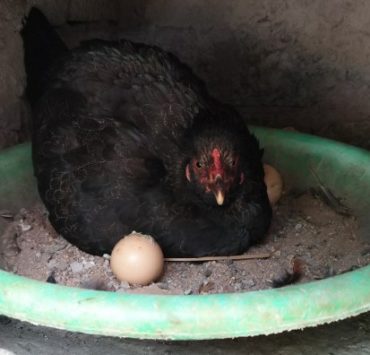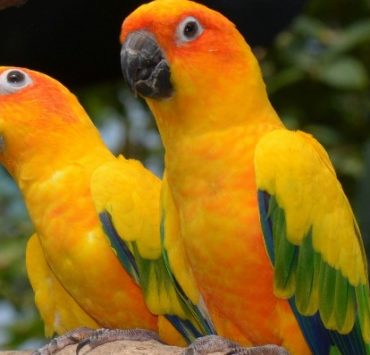
Chickens’ feet do a lot if you think about it. They are up and about all day long and only catch a break when the chickens turn in for the night. Therefore, it is not surprising that they’ll suffer from the occasional foot problem every so often.
A chicken’s foot is made up of 16 tiny interconnected bones, which give them a great deal of flexibility. Given how small they are, chicken’s feet are susceptible to injuries and infection.
One of these happens to be bumblefoot. If left untreated, this seemingly minor foot infection can be fatal if it spreads to other tissues or, worse, the bones.
This article explores everything you need to know about bumblefoot in birds and what you can do to treat it.
What Is Bumblefoot?
Plantar pododermatitis or “bumblefoot” is an infection in a bird’s feet characterized by swelling and redness with a distinguishing brownish or black scab at the bottom. The condition can present itself in several different bird species, but it is more prevalent in chickens.
If the infection is not caught and treated early on, severe bumblefoot is known to cause death in birds when the infection spreads to the underlying tissues and, eventually, the bones.
What Causes Bumblefoot?
The infection occurs when the skin on a bird’s foot is compromised in some way, allowing Staphylococcus aureus bacteria to invade the site of the injury. This then creates a pus-filled abscess that’s quite painful for the affected chicken.
The entry point for bacteria can be anything from a small scrape and cut to a raw spot on the skin of the foot, which can occur during normal foraging and scratching as they move about.
Other common causes of bird foot injuries that could give rise to bumblefoot include:
- Bullied birds at the bottom of the pecking order that get frequently chased
- Foot/leg deformities that may put uneven pressure on one of the feet
- Heavy landings from surfaces high above the ground
- Obesity, which puts undue pressure on the bird’s feet
- Overgrown toenails may impede a bird’s ability to move and/or perch properly, which increases the likelihood of a foot injury
- Poor/imbalanced diet particularly lacking in Vitamin A and biotin, which decreases the skin’s elasticity making it prone to injury
- Reduced blood supply to the feet
- Standing for extended periods
- Trauma to the foot
When the injured bird treks through poop, dirty litter, puddles, or mud, Staphylococcus bacteria enter the injured dirt-encrusted area of the foot and begin to multiply. This induces an inflammatory response from the bird’s body, which causes the site of the injury to flare up and fill with pus.
Signs That Your Bird Has Bumblefoot
The first sign that something’s wrong is usually when you notice your bird limping. As they walk, you’ll see them attempting to shift their weight off one particular foot. If the infection is severe, you’ll notice them sitting for uncharacteristically long periods.
To know for sure that they have bumblefoot vs sprained leg, you’ll need a closer inspection of their foot. This will rule out any injury resulting from an awkward landing.
If you see a swelling on the foot that feels hot to the touch (that may or may not be) accompanied by some redness, it’s an indicator that the infection is still in its initial stages.
If, on the other hand, you notice a brownish-black scab on the sole, it means the infection has been there for a while and is now in its advanced stages. When it’s at this level, it may cause secondary conditions like osteomyelitis, arthritis, and/or tenosynovitis. It may eventually lead to a crippling deformity in the bird’s foot.
How to Treat Bumblefoot
The bumblefoot treatment option available depends on the stage of the infection. It is much easier to treat the infection in its early stages. It might be as simple as changing the bird’s environment to minimize the chances of an infection developing.
If you notice any inflammation, swelling, or ulceration, it means an infection is indeed present. Treatment may involve administering bumblefoot antibiotics to cure the early stages of the infection or surgical debridement to remove the dead, non-viable tissue in advanced stages of the condition (where the brownish-black scab is present).
This procedure should only be done by a qualified avian vet. Post-surgical care and support are also necessary to ensure the foot heals properly.
Step-by-Step Procedure
Here’s how to treat bumblefoot in chickens and other birds when the foot has the black scab present.
- Prepare a warm foot bath, dissolve Epsom salts in it, and stand the chicken in it for about 20 minutes to soften up the skin of the foot
- Disinfect the site of the infection with an iodine solution to ensure it is clean before the surgical procedure begins
- Wrap the chicken in a large towel and cover their head to keep them in darkness while making sure they can still breathe. It makes it easier to control them
- Wear a pair of disposable gloves since Staphylococcus aureus can also infect humans
- Turn the bird onto their side, hold the infected foot in one hand, and a sterile scalpel in the other
- Proceed to cut around the edge of the scab, angling the blade towards the scab’s center almost as though you’re cutting off the base of an upside-down pyramid
- Dab the area with a clean tissue or gauze to keep the site blood-free, then use a pair of tweezers to pull out the black scab
- Clean the residual hole it leaves behind with a saline solution, then fill it with Neosporin ointment
- Add some packing to the site of the wound before wrapping it in a bandage. Use duct tape to hold it in place
- Clean the wound and change the dressings daily
Nip It in the Bud
To minimize the chances of your birds developing bumblefoot, give your flock a balanced diet to boost their immune system, clean the coop, and change the bedding every other day to prevent bacteria from building up.
Remove anything on the ground or perches that may cause injuries to the foot as well.
Finally, carry out regular foot inspections to catch any potential infections early on before they become problematic.
For more information on bird health, use our online Vet Chat to talk to any of our qualified avian veterinarians today.




